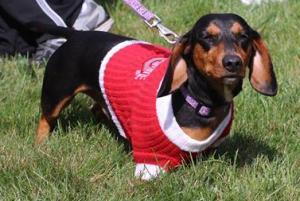Intervertebral Disk Disease in Dogs
- posted: Nov. 17, 2015

Ow, My Aching Back!
I feel like I have had a run on dogs with back and neck injuries lately. I’m not sure why there have been so many cases—I don’t think any of these dogs are doing heavy lifting or the Insanity Workout—but disk disease and other back or neck problems are fairly common in dogs.
What actually happens when a dog has disk disease? The disk is the cartilage pad that acts as the cushion between the vertebrae or bones that make up the spine and allows it to be flexible. The spinal cord is also housed and protected by the vertebrae. Older dogs and dogs with long backs like have a higher incidence of disk disease, but any dog can injure her back if she happens to jump or twist the wrong way. Dachshunds are the poster children for intervertebral disk disease with their short legs and long bodies. Essentially what happens is that the cartilage disks may become mineralized and pop out of place putting pressure on the long spinal cord and sensitive nerves that surround it or the disks can gradually degrade with age and collapse protruding into the space around the cord. This is basically what we call a herniated or “slipped” disk.
This pressure on the sensitive spinal cord causes severe pain and may even cause temporary or permanent paralysis depending on how much inflammation and compression occur to the spinal cord. Symptoms may vary slightly depending on the location of the affected cord, for example, neck vs. lumbar back. Dogs with cervical disk disease affecting the neck will often be extremely painful and yelp when touched anywhere on the body, but especially around the head or neck. They will often be reluctant to walk up or down stairs and will stand with their neck extended, not wanting to bend their heads. They may have a stiff gait and may have pain and partial paralysis of both front and hind legs. Dogs with lumbar pain will be painful when their mid to lower back is touched and may have trouble jumping with paralysis of the hind legs. Dogs that are stumbling, uncoordinated or dragging their hind legs often have significant compression of their spinal cords and should be examined immediately. Some cases of disk disease can cause permanent irreversible paralysis of the hind legs leaving the dog unable to walk.
Most dogs with mild to moderate disk disease can be treated with a combination of anti-inflammatory drugs, pain medications or muscle relaxers and strict cage rest. Steroids are often used to decrease inflammation around the spinal cord, but sometimes we use aspirin-like drugs called NSAIDs or non-steroidal anti-inflammatories. More serious cases in which the dog shows signs of complete paralysis or who do not respond to or become worse while on medication and rest may need to be referred to a veterinary neurologist for surgery to remove the ruptured or damaged disk thus relieving pressure on the spine. Those with permanent paralysis may be able to get around using a cart.
I am happy to report that none of my patients have had permanent paralysis but some have had a long recovery period and have needed multiple drugs to relieve pain and inflammation. A few have needed to have surgery but all seem to be on the mend. If your dog shows signs of extreme pain or sudden loss of function especially in his hind legs, do not delay in taking him to the vet. Early intervention is the key to preventing permanent paralysis and relieving pain.
This blog brought to you by the Patton Veterinary Hospital serving Red Lion, York and the surrounding communities.
Location
Patton Veterinary Hospital
425 E Broadway
Red Lion, PA 17356
